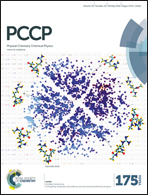A systematic investigation of acetylene activation and hydracyanation of the activated acetylene on Aun (n = 3–10) clusters via density functional theory†
Abstract
A systematic investigation of the selective catalytic conversion of poisonous HCN gas through hydracyanation of C2H2 activated on Au clusters, presented here for the first time, is of paramount importance from both scientific and technological perspectives. Hydracyanation of activated acetylene on an Au-cluster based catalyst leads to vinyl isocyanide (H2C![[double bond, length as m-dash]](https://www.rsc.org/images/entities/char_e001.gif) CHNC) formation, a versatile chemical intermediate. Using density functional theory, bond activation of acetylene and selective catalytic hydracyanation of activated acetylene on small gold clusters Aun (n = 3–10) have been studied through a detailed analysis of the geometric and electronic structures. Different possible complexes of Aun–CHCH have been studied and two possible modes of adsorption of acetylene over the gold clusters, namely, the π- and di-σ modes, have been observed. The hydracyanation of the acetylene molecule is found to occur via the cleavage of one of acetylene triple bonds at the cost of formation of two Au–C bonds followed by the binding of HCN to the activated C
CHNC) formation, a versatile chemical intermediate. Using density functional theory, bond activation of acetylene and selective catalytic hydracyanation of activated acetylene on small gold clusters Aun (n = 3–10) have been studied through a detailed analysis of the geometric and electronic structures. Different possible complexes of Aun–CHCH have been studied and two possible modes of adsorption of acetylene over the gold clusters, namely, the π- and di-σ modes, have been observed. The hydracyanation of the acetylene molecule is found to occur via the cleavage of one of acetylene triple bonds at the cost of formation of two Au–C bonds followed by the binding of HCN to the activated C![[double bond, length as m-dash]](https://www.rsc.org/images/entities/char_e001.gif) C bond via nitrogen's lone pair. Preferential binding sites for HCN and C2H2 are analyzed through Fukui function calculations, frontier molecular orbital analysis and natural population charge distribution analysis. Based on adsorption energies, odd-sized Aun clusters are found to be significantly more favorable for C2H2 adsorption with the C–C bond stretching up to 1.31 Å with respect to the C–C triple bond length of 1.21 Å in the gas phase. The stretching frequency of adsorbed complexes, C2H2/Aun, (3460 cm−1), decreases notably relative to the frequency of the free acetylene molecule (7948 cm−1), which is a signature of the bond activation of the acetylene molecule over the Au clusters. The high adsorption energy of HCN on the Au9–C2H2 complex implies the considerable binding strength and activation of C2H2 and HCN on the Au9 clusters. Due to the importance of polymerization/cyclotrimerization of C2H2 in synthetic fiber industries, the capability of Au9 clusters to adsorb up to four acetylene molecules, (C2H2)n (n = 1–4), on adjacent sites without affecting the planarity/structure of Au9 is demonstrated here for the first time. Our findings provide valuable guidance for choosing a suitable substrate/support for realizing these Aun-catalyzed reactions in practical applications.
C bond via nitrogen's lone pair. Preferential binding sites for HCN and C2H2 are analyzed through Fukui function calculations, frontier molecular orbital analysis and natural population charge distribution analysis. Based on adsorption energies, odd-sized Aun clusters are found to be significantly more favorable for C2H2 adsorption with the C–C bond stretching up to 1.31 Å with respect to the C–C triple bond length of 1.21 Å in the gas phase. The stretching frequency of adsorbed complexes, C2H2/Aun, (3460 cm−1), decreases notably relative to the frequency of the free acetylene molecule (7948 cm−1), which is a signature of the bond activation of the acetylene molecule over the Au clusters. The high adsorption energy of HCN on the Au9–C2H2 complex implies the considerable binding strength and activation of C2H2 and HCN on the Au9 clusters. Due to the importance of polymerization/cyclotrimerization of C2H2 in synthetic fiber industries, the capability of Au9 clusters to adsorb up to four acetylene molecules, (C2H2)n (n = 1–4), on adjacent sites without affecting the planarity/structure of Au9 is demonstrated here for the first time. Our findings provide valuable guidance for choosing a suitable substrate/support for realizing these Aun-catalyzed reactions in practical applications.


 Please wait while we load your content...
Please wait while we load your content...